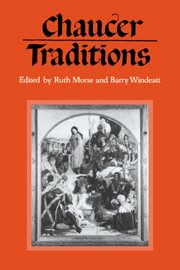Book contents
- Frontmatter
- Contents
- List of contributors
- Preface
- Note on the text
- 1 Chaucer traditions
- 2 Gower–Chaucer's heir?
- 3 Chaucer and Lydgate
- 4 Hoccleve and Chaucer
- 5 Chaucer and fifteenth-century romance: Partonope of Blois
- 6 Some Chaucerian themes in Scottish writers
- 7 The planetary gods in Chaucer and Henryson
- 8 Gavin Douglas: ‘Off Eloquence the flowand balmy strand’
- 9 Skelton's Garlande of Laurell and the Chaucerian tradition
- 10 Chaucerian metre and early Tudor songs
- 11 Aspects of the Chaucerian apocrypha: animadversions on William Thynne's edition of the Plowman's Tale
- 12 The shape-shiftings of the Wife of Bath, 1395–1670
- 13 The genius to improve an invention: transformations of the Knight's Tale
- 14 From the Clerk's Tale to The Winter's Tale
- 15 The Virtuoso's Troilus
- 16 Rewriting romance: Chaucer's and Dryden's Wife of Bath's Tale
- 17 Chaucer's religion and the Chaucer religion
- 18 A list of the published writings of Derek Brewer
- Index
14 - From the Clerk's Tale to The Winter's Tale
Published online by Cambridge University Press: 23 September 2009
- Frontmatter
- Contents
- List of contributors
- Preface
- Note on the text
- 1 Chaucer traditions
- 2 Gower–Chaucer's heir?
- 3 Chaucer and Lydgate
- 4 Hoccleve and Chaucer
- 5 Chaucer and fifteenth-century romance: Partonope of Blois
- 6 Some Chaucerian themes in Scottish writers
- 7 The planetary gods in Chaucer and Henryson
- 8 Gavin Douglas: ‘Off Eloquence the flowand balmy strand’
- 9 Skelton's Garlande of Laurell and the Chaucerian tradition
- 10 Chaucerian metre and early Tudor songs
- 11 Aspects of the Chaucerian apocrypha: animadversions on William Thynne's edition of the Plowman's Tale
- 12 The shape-shiftings of the Wife of Bath, 1395–1670
- 13 The genius to improve an invention: transformations of the Knight's Tale
- 14 From the Clerk's Tale to The Winter's Tale
- 15 The Virtuoso's Troilus
- 16 Rewriting romance: Chaucer's and Dryden's Wife of Bath's Tale
- 17 Chaucer's religion and the Chaucer religion
- 18 A list of the published writings of Derek Brewer
- Index
Summary
That the Clerk's Tale was one of Chaucer's most popular tales in the fifteenth century there can be little doubt because it was excerpted more than any other tale apart from the Prioress's Tale. That its popularity extended into the sixteenth century it will be my first aim to show, by looking at the evidence for Chaucerian influence on the two surviving ‘Patient Grissel’ plays (already investigated briefly by Thompson) and at the prose Chapbook and the Ballad on the same subject probably composed in the 1590s. Chaucer's Works were published six times in the sixteenth century (by Pynson in 1526, by Thynne in 1532 – the edition from which I will quote – 1542 and 1550, and in new editions in 1561 and 1598), and so would have been readily available to the authors of these four texts. Can his influence be seen in them, and if so what parts have they chosen to include or ignore, and why?
My second aim will be to see whether Greene was influenced by the Grissel story when he wrote Pandosto in 1588, and whether Shakespeare was influenced directly by either Chaucer's or any sixteenth-century retelling of the Grissel story when he adapted Pandosto into The Winter's Tale in (or shortly before) 1611. E. T. Donaldson has forged a path for such a study by opening up the possibility that Shakespeare's Chaucer sources extend beyond the now well-established Knight's Tale and Troilus and Criseyde
- Type
- Chapter
- Information
- Chaucer TraditionsStudies in Honour of Derek Brewer, pp. 199 - 212Publisher: Cambridge University PressPrint publication year: 1990
- 2
- Cited by



